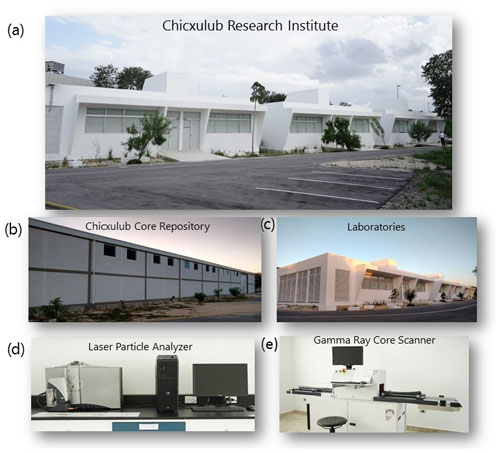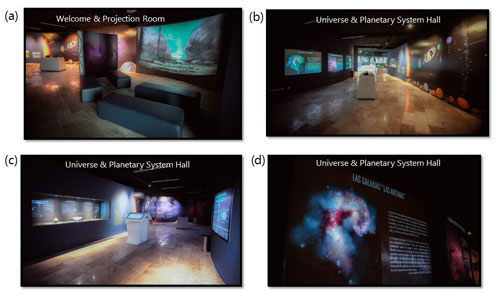the Creative Commons Attribution 4.0 License.
the Creative Commons Attribution 4.0 License.
Chicxulub museum, geosciences in Mexico, outreach and science communication – built from the crater up
Jaime Urrutia-Fucugauchi
Ligia Perez-Cruz
Araxi O. Urrutia
The Chicxulub science museum is special, in that it is built around an event in geological time representing a turning point in the planet's history and which brings together the Earth system components. Studies on the Chicxulub impact, mass extinction and Cretaceous–Paleogene boundary provide an engaging context for effective geoscience communication, outreach and education. The museum is part of a research complex in Yucatán Science and Technology Park in Mexico. Natural history museums with research components allow for the integration of up-to-date advances, expanding their usefulness and capabilities. The impact ranks among the major single events shaping Earth's history, triggering global climatic change and wiping out ∼76 % of species. The ∼200 km Chicxulub crater is the best preserved of three large terrestrial multi-ring impact structures, being a natural laboratory for investigating impact dynamics, crater formation and planetary evolution. The initiative builds on the interest that this geological site has for visitors, scholars and students by developing wide-reaching projects, a collaboration network and academic activities. The Chicxulub complex serves as a hub for multi- and interdisciplinary projects on the Earth and planetary sciences, climate change and life evolution, fulfilling a recognized task for communication of geosciences. After decades of studies, the Chicxulub impact remains under intense scrutiny, and this programme with the core facilities built inside the crater will be a major player.
- Article
(4906 KB) - Full-text XML
- BibTeX
- EndNote
Geosciences in Mexico has a rich tradition that can be traced to the Meso-American cultures. Considering the intense tectonic, seismic and volcanic activity, energy and mineral resources and diverse geological record, the geosciences play minor roles in social, academic and political discussion. Addressing this situation requires the development and implementation of effective geoscience communication and education programmes. The Chicxulub science museum developed around a unique geological event that marks the transition of the Mesozoic and Cenozoic eras provides the context for a major programme, which is based on the studies of the end-Cretaceous mass extinction, Chicxulub impact and Cretaceous–Paleogene (K–Pg) boundary.
Natural history and geological museums have a rich tradition in which collections of rocks, minerals, meteorites and fossils play an important role in non-formal education, with high learning potential for students, museum–school synergies, science engagement and teachers' professional development (Stevenson, 1991; Allen, 2004; Panda and Mohanty, 2010; Dahlstrom, 2014; Mujtaba et al., 2018). Museums with research departments allow for the integration of scientific advances, taking advantage of thematic exhibits, interactive displays and virtual reality experiences (Collins and Lee, 2006; Panda and Mohanty, 2010; Louw and Crowley, 2013).
Field trips to geological sites are important components of university educational programmes and professional workshops, meetings and congresses. National parks, UNESCO Global Geoparks and UNESCO heritage natural sites attract large numbers of scholars and students, as well as visitors. Museums of natural history, geology and mineralogy present exhibits related to life evolution, fossil record, planetary exploration, plate tectonics and meteorite impacts (MacFadden et al., 2007; Koeberl et al., 2018). Some, such as the Smithsonian National Museum of Natural History, the British Museum, the Geological Museum of China, the Museum of Natural History of Paris, the Natural History Museum Vienna and the Geological Museum of Barcelona, among many others, have rich fossil, meteorite and mineralogical collections (Komorowski, 2006; Koeberl et al., 2018). Geological site and crater museums are less numerous and include the Ries Crater Museum in Nôrdlingen, Germany, the Meteor Crater Museum in Arizona, United States, the Tswaing Crater Museum in South Africa, the Steinheim Crater Museum in Germany and the Meteorite Museum, Rochechouart, France (Pôsges, 2005; Buchner and Pôsges, 2011).
The Chicxulub complex (CIRAS), with the science museum, laboratories and core repository, is housed in Yucatán Science and Technology Park (PCYTY), southern Mexico (Figs. 1 and 2). The museum builds on the interest generated by the Chicxulub impact and the K–Pg mass extinction, which includes the dinosaurs, ammonites, marine and flying reptiles, among many organisms. Here we outline how it has developed and examine the potential that a facility built around an attractive unique event and geological site offers, including the challenges ahead.
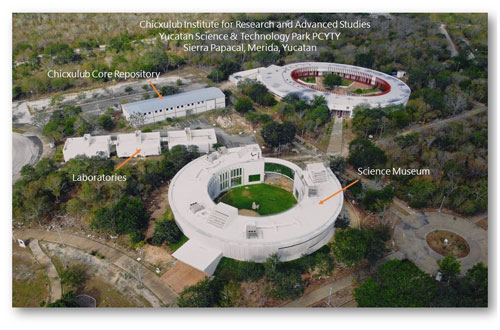
Figure 1Chicxulub Center for Scientific Research and Advanced Studies in the Yucatán Science City of the Parque Cientifico y Tecnologico de Yucatán. Views of the Chicxulub research complex, with the museum, laboratories and core repository (photos: J. Martinez, Z. Mendoza).
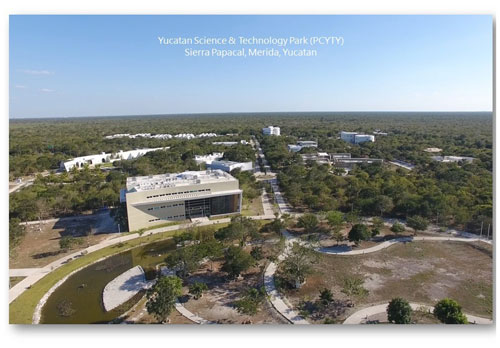
Figure 2Yucatán Science City (Parque Cientifico y Tecnologico de Yucatán, PCYTY) in Sierra Papacal, Yucatán, Mexico. View to the south of the central PCYTY sector, with the central library building (drone image: Parque Cientifico y Tecnologico de Yucatán: https://www.pcty.com.mx; last access: 12 October 2019).
Understanding Earth's origin and evolution, geologic time, tectonic processes, rock and fossil record, life evolution and extinction presents challenges that have been considered in designing the Chicxulub exhibits and activities. The link to research allows for interactions of researchers and students with visitors through conferences, seminars and workshops and visits to the laboratories and geological sites. How this translates to better appreciation and understanding of Earth and planetary sciences and science communication is a major part of the planning. Other issues on popular attractive themes like meteorite impacts and dinosaur extinction provide attractive contexts for geoscience engagement.
Research groups in Mexico have developed public outreach projects on hazard risks, climate change, mineral and energy resources, renewable energy and environmental impacts. Nevertheless, we are yet to have long-term programmes and effective influence on the education system, policy decision-making and society.
The number of researchers is small compared to the size of the country and the economy, which is a limitation shared with developing countries. The Earth sciences system focuses on a wide range of research projects that have expanded over the past years (Atlas de la Ciencia Mexicana, 2012). The Seismological Survey, Geomagnetic Observatory and Tidal Service are operated by the National University of Mexico. Federal institutions include the Mexican Geological Survey, National Institute of Information and Statistics, National Center of Disaster Prevention, National Meteorological Service and National Water Commission and Tidal Service, which carry out the cartography and coordinate the instrumental networks. The oil company Petróleos Mexicanos (Pemex) and the Petroleum Research Institute conduct marine and land oil and gas exploration and production projects.
The geosciences programme aims to develop a strategy linking research, policymakers and society, with the Chicxulub complex providing the physical and human capacities that allow for the expansion of objectives, capacity-building, outreach and educational and operational activities. Coordinated projects and policy decision initiatives are needed, including those on disaster prevention and mitigation, climate change, land management, sustainable programmes, country-wide geophysical surveys, renewable energy resources, oceanographic and marine geophysical surveys and monitoring instrumental networks.
With the globalized economy, population growth and demographic changes, the demand on energy and mineral resources has increased worldwide. In parallel, climate change, earthquakes, volcanic eruptions, tsunamis and hydrometeorological phenomena, contamination, deforestation, extinctions and sea-level rise affect societies. The transformation from free-market societies to knowledge societies, based on and driven by science and technology highlights the role of geosciences internationally. In countries like Mexico, where energy and mineral resources are major components of the economy, and where geophysical phenomena pose risks to the population, geosciences might be expected to be one of the country's priorities. This is not the case, which emphasizes the need for informing decision makers and society on the role of geosciences in the planet's conservation and sustainable development.
International programmes offer collaboration opportunities for developing countries. Mexico has participated in international programmes like the International Geophysical Year, Polar Year, Upper Mantle, Geodynamics, International Lithosphere Programme (ILP), International Ocean Discovery Programme (IODP), International Continental Drilling Programme (ICDP) and International Geosphere–Biosphere programme. It recently formed part of the United Nations International Year of Planet Earth (IYPE), International Council of Science (ICSU) Future Earth programme and UNESCO geosciences programmes. Our programme linked to these initiatives integrates Chicxulub drilling and geophysical surveys and the participation in IODP, ICDP, IYPE and ILP projects.
The Chicxulub impact marks a major event shaping life on Earth (Alvarez et al., 1980; Schulte et al., 2010). The impact marks the end of the Mesozoic Era, with the mass extinction wiping out ∼76 % of species including dinosaurs, ammonites, marine and flying reptiles, and the start of the Cenozoic that saw important radiations of many groups including mammals and birds. The Chicxulub structure formed by an asteroid impact on the Yucatán carbonate platform in the southern Gulf of Mexico was first identified in the Pemex exploration surveys and drilling programmes (Penfield and Camargo, 1981). Chicxulub is a complex crater with a ∼200 km rim diameter (Fig. 3), which has been investigated by an array of geophysical/geological surveys and drilling programmes (Fig. 4; Hildebrand et al., 1991, 1998; Sharpton et al., 1992; Urrutia-Fucugauchi et al., 2008).
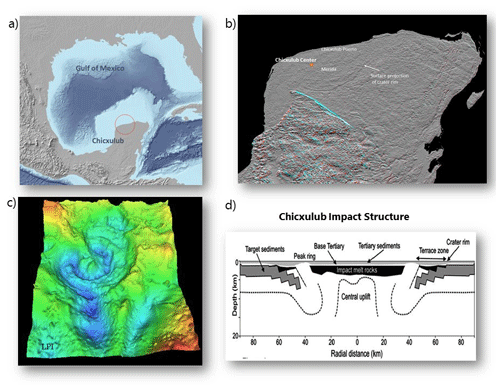
Figure 3Chicxulub crater. (a) Map of Gulf of Mexico and Yucatán Peninsula, showing location of the Chicxulub crater. (b) Satellite interferometry radar image of the northern Yucatán Peninsula (image courtesy of NASA Jet Propulsion Laboratory), showing the surface topographic semi-circular depression above the buried Chicxulub crater rim. The location of the Chicxulub CIRAS centre is shown by the star and arrow. Also marked for reference is the location of Mérida and Chicxulub Puerto. (c) Chicxulub crater gravity anomaly (Sharpton et al., 1993), showing the concentric semi-circular pattern, with the central gravity high and gravity rings marking the peak-ring and multi-ring morphology. (d) Schematic structural model showing the basin, central uplift, terrace zone, melt sheet, breccias and target Cretaceous sediments (Collins et al., 2008).
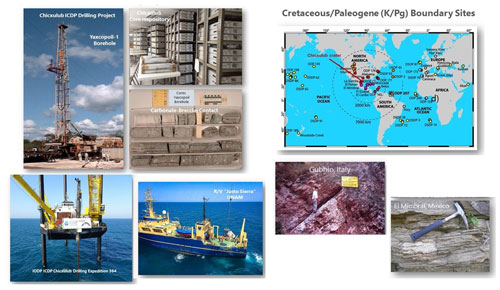
Figure 4(a) Chicxulub drilling programmes. View of the drill rig for the Yaxcopoil-1 borehole, core samples for the impact breccias–Paleocene carbonates contact and core repository. (b) View of drilling platform for the Chicxulub IODP-ICDP Expedition 364 drilling project over the peak-ring zone. Marine geophysical surveys, view of the UNAM R/V Justo Sierra. (c) The Cretaceous–Paleogene (K–Pg) boundary is marked globally by the ejecta layer (Schulte et al., 2010). K–Pg boundary sites record a major event in life evolution. In the Gulf of Mexico–Caribbean Sea area, the boundary is characterized by high-energy sediments between the basal spherules and clay layers.
The K–Pg boundary is marked globally by the impact ejecta layer, characterized by the iridium and platinum group elements derived from the impacting body (Fig. 4c; Schulte et al., 2010). The impact and its effects on Earth's climate and life evolution have been intensively studied (Alvarez et al., 1980; Mukhopadhyay et al., 2001; Schulte et al., 2010; Urrutia-Fucugauchi et al., 2011; Lowery et al., 2018). The impact had short- and long-term global effects on the climate and environment, providing lessons for understanding the impact of man-made greenhouse emissions. Although the mechanisms for the extinction and subsequent species diversification remain under scrutiny, studies of this mass extinction uncover general principles governing species/clade resilience and evolvability in response to rapid climate and environmental changes. So, in summary, Chicxulub presents an opportunity to showcase the holistic and integrated nature of Earth system science.
The CIRAS research and museum facilities are located in the central sector of Yucatán Science and Technology Park (Figs. 1 and 2). CIRAS is a joint project between the National University of Mexico, the National Council of Science and Technology and the Ministry of Science and Higher Education of the Yucatán government that has developed for a decade.
From the initial phases, the plan included the site museum on the Chicxulub impact and its effects on the planet and life evolution. The first phase was completed in 2011 with the Chicxulub museum housed on the second and third floors of the PCYTY central library (Fig. 5). The second phase was the Chicxulub exhibition in the Meteorite Hall of the Grand Museum of the Mayan World (Gran Museo de Mundo Maya) in Mérida (Fig. 6). Inaugurated on 12 December 2012, the Chicxulub exhibition was awarded the 2013 Miguel Covarrubias prize from the National Institute of Anthropology and History.
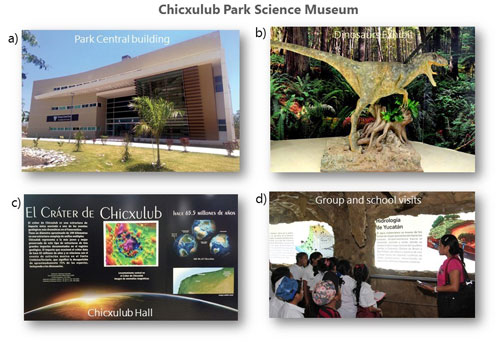
Figure 5Chicxulub science museum in the PCYTY Yucatán Science Park. The central library building houses the museum in the second and third floors. Views of the exhibits are also shown (see also Perez-Cruz and Urrutia-Fucugauchi, 2015).
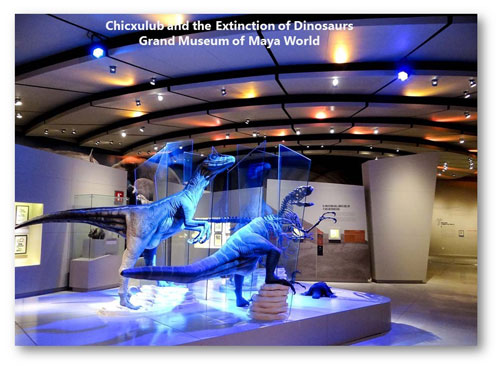
Figure 6Partial view of displays of the exhibition on Chicxulub and the extinction of dinosaurs in the Gran Museo Mundo Maya in Mérida, Yucatán.
The Chicxulub exhibition in the Grand Museum of the Maya World attracted large numbers of visitors, students and researchers. The Chicxulub impact and extinction of dinosaurs exhibition was planned to cover the time of the Mayan prophecy of the end of the world and included displays on historical accounts of catastrophic prophecies of various cultures. The exhibition addressed beliefs on celestial phenomena such as comets and lunar and sun eclipses, which in some societies were associated with catastrophes, diseases, warfare and social unrest. The contrasting views were presented in the framework of the Chicxulub impact, extinction of dinosaurs and other species and the end of the Mesozoic Era.
Museum visits start with a video presentation on the Chicxulub impact and mass extinction, followed by introductions to comets, asteroids and meteorites, early observations of meteorite falls and cometary showers and how they evolved as part of the studies of the planetary system. A major component is the exhibits of the fossil record, geologic time and evolution of the dinosaurs, marine microorganisms, ammonites and flying and marine reptiles. Initial Chicxulub studies were linked to oil exploration in southern Mexico and the geological characteristics of the Yucatán Peninsula (Urrutia-Fucugauchi et al., 2013). Exhibits display surface geological processes, with the aquifer, groundwater flow and fracturing influenced by the buried crater, which can be traced by the ring of cenotes and semicircular topographic depression over the crater rim. Related programmes at the museum are the conferences, seminars and symposia, including the progress reports of the research and drilling projects.
The PCYTY Chicxulub museum has attracted large numbers of visitors. Entrance is free, and records are only for the guided tours and appointed visits of school children. In 4 years, the number of visitors was around 17 000, including 6000 school students and 1000 pre-school children. The visitors to the Chicxulub Exhibition at the Grand Museum have been more numerous, due to its association with the archaeological exhibits and easy access in Mérida. Comments and responses discussed below come mainly from the student groups and teachers, with additions from groups during conferences and seminars. The guided tours for school groups offered the advantage of engaging with the teachers, which provided valuable interactions and feedback. In connection with the museum exhibits, conference series and workshops were held with the participation of students and researchers, among them, workshops on drilling and marine geophysics projects and on geosciences education.
Around the initial plan, research facilities expanded to include laboratories and the core repository built in the Yucatán Science Park, which houses academic and research institutions, start-ups and research-oriented firms, including Yucatán State University, National University of Mexico and National Council of Science centres. The CIRAS construction project took several years, with the centre formally established in February 2018 (Fig. 7). It has access to the national hydrocarbon core repository and the apartment blocks to host visiting academics and students. The third phase started in 2016, with construction of the larger museum facilities.
5.1 Science museum
Studies on large meteorite impacts, dinosaurs, mass extinctions and life evolution attract the interest of wide audiences, opening interesting possibilities for science communication. The exhibits are organized around =studies of the solar system, impact cratering, evolution of planetary surfaces, Chicxulub impact, crater formation, impact effects on climate and life-support systems, extinction of organisms, biotic turnover and life evolution. Exhibits aim to present to, inform, engage and entertain visitors through studies on the Chicxulub impact, life evolution, K–Pg turnover and related inter- and multidisciplinary research (Figs. 8, 9 and 10).
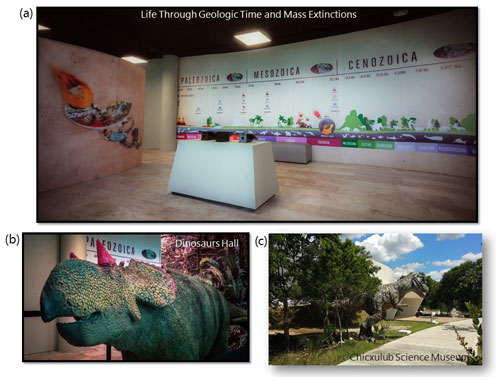
Figure 10Chicxulub science museum and exhibits on life evolution and mass extinctions. Exhibits on dinosaurs and other flying and marine reptiles are arranged inside and in the museum surroundings.
Exhibits on the universe hall present an introduction to the origin and evolution of the universe, the formation of stars and galaxies, the Milky Way galaxy and the solar system (Figs. 8 and 9). The formation of planetary systems involves dynamic processes with collisions at different scales, with the formation of first solids, planetesimals and large bodies. The origin and evolution of planetary systems are marked by collisions of bodies, which are the main process in the formation of planets, satellites, dwarf planets, asteroids and comets. Impact craters characterize the surfaces of solid planetary bodies and constitute the geological record of the dynamic evolution through time and space.
The hall on the solar system and impact cratering presents an engaging introduction on the characteristics and evolution of planetary surfaces, impact dynamics, crater formation, impacts on time and space, comets, near-Earth asteroids and impact hazards. Hypervelocity impacts deliver high amounts of energy on short timescales, resulting in deep excavation cavities, material transport and deformation. Planetary surfaces preserve records of impacts, with the magnitude and frequency of impacts higher in the early stages. Impact cratering is a major process in the evolution of planetary surfaces and deep interiors. The terrestrial record has been erased and modified, with a limited number preserved in contrast to other bodies like the Moon, Mars, Venus and Mercury.
The exhibits on the Chicxulub structure introduce the crater and impact effects. The large multi-ring crater is the best preserved of the three large impact structures in the terrestrial record, being a laboratory for investigating impact dynamics, crater formation and planetary surface evolution (Melosh, 1989; Urrutia-Fucugauchi and Perez-Cruz, 2009). The structure is located half on land and half offshore, with the geometric centre at Chicxulub Puerto on the coastline.
The hall on the end-Cretaceous extinction and life evolution introduces the effects of the meteorite impact on life-support systems, linking the impact with the mass extinction. Exhibits introduce the fossil record, geological processes, geological timescale and concepts of deep time and life evolution. The mass extinction marks the boundary between geological eras, which in the geological record is marked by the Chicxulub ejecta layer. Interactive exhibits introduce macroevolutionary trends, with the effects on species communities and diversification after the impact.
Exhibits include challenging themes on life evolution, extinctions, emergence of species, macroevolution and climate change (Sepkoski, 1998; Jablonski, 2005, 2008). Experiences in natural history and science museums emphasize the roles of teachers and museum staff in interacting with visitors, particularly with school groups and students, on difficult topics. This is the case with exhibits on the end-Cretaceous mass extinction and asteroid impact effects that allow issues such as present-day global warming, environmental problems and extinctions to be addressed.
The museum includes an auditorium, meeting rooms and a projection room, used to present videos and animations of the Chicxulub impact, plus a children's playing room. An independently managed coffee shop and souvenir stores complement the facilities. The museum has spaces to host temporary exhibits on the Gulf of Mexico–Caribbean Sea, mineral and energy resources, global climate change and biodiversity, which offer collaboration programmes with other institutions. Spaces around the museum incorporate outdoor exhibits (dinosaurs and marine and flying reptiles) that take advantage of the vegetation with endemic plants and large-size fossiliferous carbonate rock boulders (Fig. 10). Additionally, the PCYTY botanical garden is next to the museum, which is open for join activities.
5.2 CIRAS research areas
The institute, core repository and six laboratories have analytical facilities for core analyses, sample preparation, petrography, micropaleontology, geochemistry and physical properties. Laboratories are equipped with core scanners, an X-ray fluorescence system, a gamma-ray core logging system, magnetic susceptibility meters, an electrical resistivity meter, petrographic microscopes, a laser particle analyser and an electronic scanning microscope (e.g. shown in Fig. 7d and e). The core repository has facilities for conducting experiments, slim-core logging sensors and geophysical instruments, including gravity, resistivity and magnetic field meters.
Ongoing projects focus on studies of crater structure, dimensions, morphology, breccia deposits, the melt sheet, target deformation, the impact-induced hydrothermal system, pre-impact structures and post-impact processes. Chicxulub has been investigated with a wide array of geophysical methods, including gravity, magnetics, electromagnetics and seismic reflection (Hildebrand et al., 1998, Sharpton et al., 1993; Collins et al., 2008; Urrutia-Fucugauchi et al., 2011; Morgan et al., 2016).
The structure and ejecta are not exposed, making drilling an indispensable tool to sample the impactites and pre- and post-impact sedimentary rocks (Fig. 3). Initial drilling was carried out by Pemex oil company with intermittent core recovery, providing samples that were key for confirming the age of the impact structure (Hildebrand et al., 1991; Sharpton et al., 1992). Subsequent drilling programmes incorporated continuous core recovery and geophysical logging (Fig. 4; Urrutia-Fucugauchi et al., 2004, 2008), with tens of thousands of core samples distributed to groups in different countries, which has allowed the research on the crater and K–Pg boundary to be expanded.
Studies investigate impact effects on climate and life-support systems (Alvarez et al., 1980; Schulte et al., 2010; Urrutia-Fucugauchi and Perez-Cruz, 2016; Lowery et al., 2018), with recent ones shedding light on factors determining the likelihood of taxa becoming extinct as in the case of arboreal birds after forests disappeared (Field et al., 2018). Mass extinction was followed by radiations in numerous taxa including mammals (Dos Reis et al., 2012), worm lizards (Longrich et al., 2015) and birds (Field et al., 2018). Further understanding of the factors driving species extinction and radiations is crucial to make predictions on the effects of anthropogenic climate change.
CIRAS carries out research relevant to the communities in Yucatán, studying the low-relief karstic terrains (Fig. 3). The city of Mérida, located ∼30 km away from the coastline, is just a few metres above sea level. The platform is an extensive low-inclination shallow ramp, which records the sea-level fluctuations during the Late Pleistocene glaciation and the Holocene. Yucatán is in the trajectory of hurricanes and tropical storms, with a thin soil cover and no surface waters, and is vulnerable to coastal erosion, marine intrusion, aquifer contamination and global warming, with changes of precipitation, sea level, cloud coverage and evaporation.
The northern Yucatán Peninsula is marked with sinkholes and dissolution structures, and the buried structure exerts a strong influence on surface geological processes, including subsidence, fracturing, groundwater flow and coastal and karst processes. The density and distribution of karstic structures relate to dissolution and in turn to fracturing, topography, rainfall and groundwater flow. The sinkhole distribution correlates with the buried structure, notably with the cenote ring located over the crater rim. Surface fracturing is related to the stress/strain state, with the regional tectonics, differential subsidence of the crater fractured breccias and carbonates surrounding the crater and rheological properties of the surface formations. Coastline morphology and processes are related to the buried structure, marked by the correlation at the intersections with the gravity anomaly rings. The thick carbonate cover has protected the structure and ejecta deposits from erosion, while adding challenges for the studies. The structure, characterized on the surface by gravity and magnetic semi-circular concentric patterns (Fig. 3), is characterized by a gravity high and high-amplitude magnetic anomalies associated with the basement uplift, peak-ring and impactite deposits. The crater rim and terrace zone are marked on the surface by the cenote ring, fracturing and semi-circular topographic depression.
In Mexico, research projects address societal issues such as hazard risks, climate change, mineral and energy resources, renewable energy and environmental problems, but geoscientists have yet to have long-term programmes that have an effective public, educational and policy impact. CIRAS offers a potential facility for doing that.
It forms a collaboration network and programme hub to carry out research on the Chicxulub crater and relations to life evolution, impact dynamics and cratering and the effects on planetary scales. As such, it is developed from the studies of a unique event marking a turning point in the planet's evolution, thus offering interesting opportunities and challenges. How is the programme addressing and developing its capabilities for outreach, education and geoscience communication? How attractive is this unique geological site for engaging visitors? How are concepts such as the nature of geologic time, life evolution, fossil record, climate change introduced? How do visitors respond to exhibits and related activities?
Mass extinction provides an engaging starting point and context for addressing planetary evolution and how life evolves linked to geological processes, climate and environment. This allows for the introduction of fundamental concepts of geological time, processes, life evolution, Earth system, interconnections and the role of sudden changes.
6.1 Outreach and education
Mujtaba et al. (2018) reviewed the learning potential of natural history museums, focusing on school students, museum–school interactions, science engagement and teachers' professional development. They have a rich tradition, with exhibits, interactive displays and collections of rocks, minerals, fossils and animals and plants playing important roles in the conservation and preservation of fossils, minerals and geological sites (Lipps and Granier, 2009; Boonchai et al., 2009). Natural history exhibits and interactive displays on life evolution allow difficult concepts to be addressed that include natural selection, speciation, extinction, deep time, intense sudden high-amplitude events versus gradual incremental changes and global versus local processes and macroevolution (Baum et al., 2005; Diamond and Scotchmoore, 2006; Spiegel et al., 2012; MacDonald and Wiley, 2012). Visitors to natural history museums are in general more familiar with evolutionary concepts than those who do not have the experience. Studies on how visitors view, approach and accept, reject or ignore evolution show that those with museum experiences are more familiar with life evolution than the general public (Mujtaba et al., 2018). However, large sectors face difficulties comprehending those concepts, which is the case with topics such as climate change, global warming and anthropogenic impacts.
In the Chicxulub museum, activities include conferences, seminars, drawing contests for school children in primary schools, material/publications and interaction with teachers and schools. Two GIFT (Geosciences Information for Teachers) workshops of the European Geosciences Union (EGU) were held in Mérida in 2010 and 2016. The GIFT workshops were organized in collaboration with the Secretaries of Education and SIIES, the Mexican Academy of Sciences and scientific societies. The pan-American GIFT workshop of the EGU capacity-building programme scheduled for October 2020 in the Chicxulub museum was postponed until 2021.
Field experiences take advantage of the museum's location to enhance learning experiences from field observations of rocks, fossils and local flora and fauna. The PCYTY botanical garden, with marine-fossil-rich outcrops, further expands the museum experience. Additional activities include microscopic observations for petrographic and microfossil analyses, complementing activities in the classrooms and the museum visit. Novel avenues use the internet, digital tools, smartphone applications and new spaces, particularly for the natural and physical sciences (e.g. Braund and Reiss, 2004, 2006). Field trips to K–Pg boundary sites offer opportunities to understand the impact effects and impact geological record (Fig. 6). The nearest sites in Campeche, Quintana Roo and Belice are displayed in exhibits, maps, videos and images and are complemented by animations illustrating how ejecta was emplaced in proximal areas and at distant locations.
6.2 Challenges and approaches
The crater and proximal ejecta deposits are not exposed at the surface, which presents a challenge in comprehending the huge size and characteristics of the structure. We also found that visitors have difficulties understanding how and why dinosaurs went extinct, the dynamics of asteroid impacts and crater formation, the sequence of events, other species affected, what happened with the mammals, why and how some mammal species did not go extinct and how some species went extinct while others do not. The Chicxulub size and the relation of the buried structure to the ring of cenotes are difficult to appreciate because of the large dimensions. Following the sequence of events and crater formation in a short time and with large energy release also generates questions. For instance, many visitors consider that the impact formed the cenotes (particularly the cenote ring), though they acknowledge the crater lies deep beneath and that the cenotes are recent surface features. The origin of Chicxulub structure also generates confusion, and though there are exhibits on the craters on the Moon and other bodies, visitors have difficulty understanding impact craters and volcanic craters as formed by different geological processes.
Presenting concepts on geological time, evolution, fossil record and geological processes in an engaging way is no easy task. Museums have developed different approaches, with results showing mixed responses and the complexities of the subjects (Braund and Reiss, 2004, 2006; Allen and Gutwill, 2004; MacFadden et al., 2007; Mujtaba et al., 2018). In the museum, different approaches are tied around attractive issues. For instance, exhibits on dinosaurs attract more interest than displays on other groups, so they are taken to engage visitors. Widespread interest in dinosaurs comes from their large sizes and diversity, including the giant sauropods, predators like the T. rex and raptors and feathered dinosaurs. Long-term evolution and adaptations are introduced by showing how successful the dinosaurs were during the Mesozoic, occupying the ecosystems in the continental land masses, including the polar regions (Sereno, 1999; Barret et al., 2009).
Mammals are also attractive, particularly those on the Late Pleistocene megafauna from the Last Glacial age or the large land and marine mammals like whales and dolphins. Exhibits on human evolution and primates are more popular than similarly well-structured exhibits on other species. We use this to introduce concepts on deep time and the fossil record, with the Chicxulub exhibits on relations and evolution of the various groups, particularly the dinosaurs and mammals. Dinosaurs and mammals coexisted for a long time, with distinct spatial distributions, habitats, body masses and lifestyles. Looking at what happened after dinosaurs, marine and flying reptiles, ammonites and many other groups went extinct helps people to appreciate macroevolutionary traits, species interdependency, how species evolve and interact, how ecosystems develop and function and how species relate and react to environmental and climatic conditions (Jablonski, 2005, 2008; Bambach, 2006; Barrett et al., 2009).
The end-Cretaceous mass extinction is the fifth and last mass extinction in the geologic record (Emiliani et al., 1981; Bambach, 2006). Exhibits on the Phanerozoic extinction events are also presented, focusing on the marine and land realms, introducing macroevolution and changes through time (Sepkoski, 1998; Jablonski, 2005, 2008). Adding paleogeographic reconstructions allows for the visualization of the evolving distribution of continents and oceans, particularly the assemblage of Pangaea and its break-up and its drifting apart, which form the backdrop for life evolution.
How Earth systems interconnect is addressed, showing the impact effects on the climate and environment, with the sharp sudden period of darkness and cooling caused by the fine dust ejecta in the stratosphere followed by warming due to the massive injection of greenhouse gases (Alvarez et al., 1980; Alvarez, 1997; Schulte et al., 2010). The deposition of the fine ejecta resulted in changes in seawater chemistry, affecting the marine organisms. The warm climates of the Cretaceous were followed by a cooling trend during the Cenozoic, with the formation of the ice polar caps and eventually the Late Pleistocene glaciation (Zachos et al., 2008). The evolution of the different genera, families and species correlates with the changing paleogeography and climate.
Museum visitors often have problems grasping details of evolutionary processes (MacFadden et al., 2007; Mujtaba et al., 2018), which illustrates the challenges, particularly for non-formal curricula and learning outside the classroom. It highlights the role and importance of formal and informal education and outreach programmes, with science museums and supplementary activities directed to inform and engage on what science is and represents (Stevenson, 1991; Allen, 2004; Allen and Gutwill, 2004). What is the scientific method, and what makes it unique in understanding the natural world? In recent years, with the development of molecular biology, genetics, molecular clocks and metagenomics, evolutionary studies have entered a new field (Chen et al., 2014). Introducing new developments and findings presents opportunities and challenges. Recent discoveries provide unprecedented detail, which allow for a narrative of events, integrating evidence in a multidisciplinary approach.
6.3 Geoscience communication
Outreach and geosciences communication programmes integrate research components with developments and challenges, reflected in the exhibits, interactive displays and virtual reality experiences (Louw and Crowley, 2013). Museum exhibits cover a multidisciplinary range of topics, from the physics of hypervelocity impacts, high-pressure and high-temperature processes and rheological properties to the delicate balance of geological processes and life evolution. The museum provides a forum for outreach, educational and science communication, although its potential needs to be further developed.
CIRAS addresses matters relevant to policy making and the society. What is critical is having a better structured relationship with other components of the science park and academic network and a science communication programme with a wide scope and defined priorities (Stewart and Nield, 2013; Stewart and Lewis, 2017). The programmes for visiting researchers and postgraduate students, publications and partnership with the Consortium of Universities for Science expand the academic programme. The CIRAS programme includes a weekly seminar series on Chicxulub, mass extinction, Yucatán and the Gulf of Mexico and workshops on technical and science communication themes.
CIRAS conducts geophysical and environmental impact studies, with societal relevance. Partnership with PCYTY research centres and the National Oil Core Repository expands collaborations and joint activities. Projects in the energy sector that include oil and gas exploration in the Gulf of Mexico and renewable energy are some of the priorities in Yucatán. The joint projects include laboratory core analyses, geochemistry, petrology, biostratigraphy, magnetostratigraphy and physical properties, as well as exhibits on oil and gas exploration of the Gulf and southern Mexico (planned for the oil core repository).
The Chicxulub newsletter, in its fourth year, is published every 3 months, with notes and articles on research projects, seminar summaries and news. The Consortium of Universities for Science formed by institutions in Mexico, the United States, the UK and Brazil coordinates the seminar series with weekly conferences, a science documentary cycle (with discussions by invited specialists), media interviews and special events. Seminars have addressed Chicxulub drilling projects, life recovery after the impact, K–Pg mass extinction and post-impact radiations. The 2020 seminar series addressed life evolution, genomics, climate change and health studies, including the Covid-19 pandemic. Special events include conferences on the Maya civilization, cosmology and quantum mechanics. The seminars and documentaries are available online in the consortium platform, which allows for a wider use in different countries.
Key aspects for science communication include climate change and effects on biodiversity and environmental affectation caused by human activity. The global changes affect biodiversity, with the loss of species that are being interpreted as the sixth mass extinction. Displays showing examples of how studies connect to life evolution are linked to familiar groups of organisms, connecting the K–Pg extinction, species evolution and the present situation (e.g. Field et al., 2018). Recent studies on the fossil record and molecular phylogenies are also displayed that show the intricate interconnections and complex responses during biotic transitions and pre- and post-extinction processes. A recognized task is the effective communication to policymakers and society (Arattano et al., 2018; Stewart and Lewis, 2017; Illingworth et al., 2018).
The Chicxulub science museum is built around a unique geological event that marks the transition of the Mesozoic and Cenozoic eras. Earth system science is captured in one place, developing wide-reaching effective science communication, educational and outreach projects, with a collaboration network and academic activities. The museum is developed from studies on the Chicxulub impact, end-Cretaceous mass extinction and the Cretaceous–Paleogene boundary and is a key component of the research complex in Yucatán Science and Technology Park in Mexico.
The Chicxulub complex is strategic to promote the geosciences in Mexico. It provides physical and human capacities that allow research, policymakers and society to interconnect. The museum is an attractive space for learning, exploring and experimenting, aimed to engage the interest of children, youngsters and adults. The research laboratories enhance the capacities, making it more inviting to learn, wonder and experiment. Science museums are linked to the development of modern societies, with science and technology being the driving forces for the transformation of societies.
The complex serves as a hub for multi- and interdisciplinary projects on the Earth and planetary sciences, climate change and life evolution, fulfilling a recognized task for communication of geosciences. With the 40th anniversary of the impact theory and discovery of the Chicxulub structure, research on the impact and mass extinction has intensified. In a wide context, enhanced understanding of the Earth system, processes, life evolution and extinctions and the impact of anthropogenic activities is critical to address geo-environmental challenges. CIRAS aims to provide scientific and technical information and advice to society and decision-makers and to construct a wide collaboration network.
Additional information on the Chicxulub programme can be provided from the authors upon request.
All authors have contributed to the study. JUF and LPC were involved from the initial stages of the project planning and outreach and geoscience communication programmes. AOU coordinated the geoscience communication activities and developed the scientific content. JUF, LPC and AOU contributed to the writing of the manuscript.
The authors declare that they have no conflict of interest.
We greatly appreciate the constructive revision of the manuscript by the editor, Iain Stewart, and the comments by the editor, Jon Tennant, Christian Koerberl, and two anonymous reviewers. CIRAS is a collaborative effort between the Ministry of Science, Innovation and Higher Education SIIES of the Yucatán government and the National University of Mexico. We thank the secretary of SIIES, Bernardo Cisneros Buenfil, and the director Ricardo Bello. The collaboration by the partners in the project Raúl Godoy Montañez, Fernando D'Acosta, Arcadio Poveda, Enrique Ortiz Lanz, Leon Faure, Zeus Mendoza, Wilbert Echeverria, Alberto Canto, Inocencio Higuera, Laura Hernández, Tomas Gonzalez and the Chicxulub group is greatly acknowledged. Raúl Godoy coordinated the Parque Científico y Tecnológico de Yucatán (Yucatán Science Park, PCYTY). The exhibition in the Gran Museo de Mundo Maya on the Chicxulub and dinosaur extinction was coordinated by Enrique Ortiz Lanz.
Partial support for the Chicxulub project has been provided by the FOMIX Yucatan Government – CONACYT (grant no. FOMIX-272761) and the Yucatan Government – National University of Mexico Collaboration Agreement (grant no. 53937-2997-14-IX-18).
This paper was edited by Iain Stewart and reviewed by Christian Koeberl and two anonymous referees.
Allen, S.: Designs for learning: Studying science museum exhibits that do more than entertain, Sci. Educ., 88, S17–S33, 2004
Allen, S. and Gutwill, J.: Designing with multiple interactions: Five common pitfalls, Curator, 47, 199–212, 2004.
Alvarez, L. W., Alvarez, W., Asaro, F., and Michel, H. V.: Extraterrestrial cause for the Cretaceous – Tertiary extinction, Science, 208, 1095–1108, 1980.
Alvarez, W.: T. Rex and the crater of doom, Princeton University Press, Princeton, NJ, USA, 185 pp., 1997.
Arattano, M., Peppoloni, S., and Gatti, A.: The ethical duty to divulge geosciences and the improvement of communication skills to fulfil it, Episode, 41, 97–103, 2018.
Atlas de la Ciencia Mexicana: Atlas de la Ciencia Mexicana, available at: http://atlasdelacienciamexicana.org/atlas_printed_version_2012-volI/pdf/atlas2012-vol1.pdf (last access: 22 February 2021), 2012.
Bambach, R. K.: Phanerozoic biodiversity mass extinctions, Ann. Rev. Earth Planet. Sci., 34, 127–155, 2006.
Barrett, P. M., McGowan, A. J., and Page, V.: Dinosaur diversity and the rock record, P. Roy. Soc. B-Biol. Sci., 276, 2667–2674, https://doi.org/10.1098/rspb.2009.0352, 2009.
Baum, D., Smith, S., and Donovan, S.: Evolution: The tree-thinking challenge, Science, 310, 979–980, 2005.
Boonchai, N., Grote, P. J., and Jintasakul, P.: Paleontological parks and museums and prominent fossil sites in Thailand and their importance in the conservation of fossils, in: PaleoParks – The protection and conservation of fossil sites worldwide, edited by: Lipps, J. H. and Granier, B. R. C., Carnets de Géologie/Notebooks on Geology, Brest, France, 2009.
Braund, M. and Reiss, M. (Eds.): Learning Science Outside the Classroom, Routledge Falmer, London, UK, 2004.
Braund, M. and Reiss, M.: Towards a more authentic science curricula: The contribution of out-of-school learning, Int. J. Sci. Educ., 28, 1373–1388, 2006.
Buchner, E. and Posges, G.: The status of the Ries Crater Museum Nordlingen, in: 2nd Arab Impact Cratering and Astrogeology Conference (Abstract), Hassan II Casablanca University, Casablanca, Morocco, 19–20, 2011.
Chen, L., Bush, S. J., Tovar-Corona, J. M., Castillo-Morales, A., and Urrutia, A. O.: Correcting for differential transcript coverage reveals a strong relationship between alternative splicing and organism complexity, Mol. Biol. Evol., 31, 1402–1413, 2014.
Collins, G. S., Morgan, J. Barton, P., Christeson, C., Gulick, S., Urrutia-Fucugauchi, J., Warner, M., and Wünnemann, K.: Dynamic modeling suggests terrace zone asymmetry in the Chicxulub crater is caused by target heterogeneity, Earth Planet. Sci. Lett., https://doi.org/10.1016/j.epsl.2008.03.032, 2008.
Collins, S. and Lee, A.: How can natural history museums report secondary science teaching and learning? A consultative study, available at: https://www.nhm.ac.uk/resources-rx/files/secondary-schools-20524.pdf (last access: 29 April 2021), London Natural History Museum/Real World Science Partnership, 2006.
Dahlstrom, M. F.: Using narratives and storytelling to communicate science with nonexpert audiences, P. Natl. Acad. Sci. USA, 111, 13614–13620, 2014.
Diamond, J. and Scotchmoore, J.: Exhibiting evolution, Museums Social Issues, 1, 21–48, 2006.
Dos Reis, M., Inoue, J., Hasegawa, M., Asher, R. J., Donoghue, P. C., and Yang, Z.: Phylogenomic datasets provide both precision and accuracy in estimating the timescale of placental mammal phylogeny, Proc. Roy. Soc. B-Biol. Sci., 279, 3491–3500, 2012.
Emiliani, C., Kraus, E. B., and Shoemaker, E. M.: Sudden death at the end of the Mesozoic, Earth Planet. Sci. Lett., 55, 317–334, 1981.
Field, D. J., Bercovici, A., Berv, J. S., Dunn, R., Fastovsky, D. E., Lyson, T. R., Vajda, V., and Gauthier, J. A.: Early evolution of modern birds structured by global forest collapse at the end-cretaceous mass extinction, Curr. Biol., 28, 1825–1831, 2018.
Hildebrand, A. R., Penfield, G. T., Kring, D., Pilkington, M., Camargo-Zanoguera, A., Jacobsen, S. B., and Boynton, W. V.: Chicxulub Crater: A possible Cretaceous/Tertiary boundary impact crater on the Yucatan Peninsula, Mexico, Geology, 19, 867–871, 1991.
Hildebrand, A. R., Pilkington, M., Ortiz-Aleman, C., Chavez, R. E., Urrutia-Fucugauchi, J., Connors, M., Graniel-Castro, E., and Niehaus, D.: Mapping Chicxulub crater structure with gravity and seismic reflection data, in: Meteorites: Flux with Time and Impact Effects, edited by: Graddy, M. M., Hutchinson, R., McCall, G. J. H., and Rotherby, D. A., Geological Society, London, Special Publications, 140, 155–176, 1998.
Illingworth, S., Stewart, I., Tennant, J., and von Elverfeldt, K.: Editorial: Geoscience Communication – Building bridges, not walls, Geosci. Commun., 1, 1–7, https://doi.org/10.5194/gc-1-1-2018, 2018.
Jablonski, D.: Mass extinctions and macroevolution, Paleontology, 31, 192–210, 2005.
Jablonski, D.: Extinction and the spatial dynamics of biodiversity, P. Natl. Acad. Sci. USA, 105, 11528–11535, 2008.
Koeberl, C., Brandstätter, F., Harzhauser, M., and Riedl-Dorn, C.: History and importance of the geoscience collections at the Natural History Museum Vienna, Geological Soc. Am. Sp. Pap., 535, 131–161, 2018.
Komorowski, C.L.C.: The meteorite collection of the National Museum of Natural History in Paris, France, Geol. Soc., London, Sp. Publ., 256, 163–204, 2006.
Lipps J. H. and Granier B. R. C. (Eds.): PaleoParks – The protection and conservation of fossil sites worldwide, Carnets de Géologie, Brest, France, ISBN 13 978-2-916733-06-7, 2009.
Longrich, N. R., Vinther, J., Pyron, R. A., Pisani, D., and Gauthier, J. A.: Biogeography of worm lizards (Amphisbaenia) driven by End-Cretaceous mass extinction, Proc. Roy. Soc. B-Biol. Sci., 282, 20143034, https://doi.org/10.1098/rspb.2014.3034, 2015.
Louw M. and Crowley, K.: New ways of looking and learning in natural history museums. The use of gigapixel imaging to bring science and public together, Curator, 56, 87–104, 2013.
Lowery, C. M., Bralower, T. J., Owens, J. D., Rodríguez-Tovar, F. J., Jones, H., Smit, J., Whalen, M. T., Claeys, P., Farley, K., Gulick, S. P. S., Morgan, J. V., Green, S., Chenot, E., Christeson, G. L., Cockell, C., Coolen, M., Ferrière, L., Gebhardt, C., Goto, K., Kring, D., Lofi, J., Ocampo-Torres, R., Perez-Cruz, L., Pickersgil, A. E., Poelchau, M. H., Rae, A. S. P., Rasmussen, C., Rebolledo-Vieyra, M., Riller, U., Sato, H., Tikoo, S. M., Tomioka, N., Urrutia-Fucugauchi, J., Vellekoop, J., Wittmann, A., Xiao, L., Yamaguchi, K., and Zylberman, W.: Rapid Recovery of Life At Ground Zero of the End Cretaceous Mass Extinction, Nature, 558, 288–291, https://doi.org/10.1038/s41586-018-0163-6, 2018.
MacDonald, T. and Wiley, E. O.: Communicating phylogeny: Evolutionary tree diagrams in museums, Evol. Education Outreach, 5, 14–28, 2012.
MacFadden, B. J., Dunckel, B. A., Ellis, S., Diekering, L. D., Abraham-Silver, L., Kisiel, J., and Koke, J.: Natural History Museum visitors' understanding of evolution, BioScience, 87, 875–882, https://doi.org/10.1641/B571010
Melosh, H. J.: Impact Cratering: A Geologic Process, Oxford University Press, New York, USA, 245 pp., 1989.
Morgan, J. V., Gulick, S. P. S., Bralower, T., Chenot, E., Christeson, G., Claeys, P., Cockell, C., Collins, G. S., Coolen, M. J. L., Ferrière, L., Gebhardt, C., Goto, K., Jones, H., Kring, D. A., Le Ber, E., Lofi, J., Long, X., Lowery, C., Mellett, C., Ocampo-Torres, R., Osinski, G. R., Perez-Cruz, L., Pickersgill, A., Poelchau, A., Rae, A., Rasmussen, C., Rebolledo, M., Riller, U., Sato, H., Schmitt, D. R., Smit, J., Tikoo, S., Tomioka, N., Urrutia-Fucugauchi, J., Whalen, M., Wittmann, A., Yamaguchi, K. E., and Zylberman, W.: The formation of peak rings in large impact craters, Science, 354, 878–882, 2016.
Mujtaba, T., Lawrence, M., Oliver, M., and Reiss, M. J.: Learning and engagement through natural history museums, Stud. Sci. Education, 54, 41–67, 2018.
Mukhopadhyay, S., Farley, K. A., and Montanari, A.: A short duration of the Cretaceous-Tertiary boundary event: Evidence from extraterrestrial helium-3, Science, 291, 1952–1955, 2001.
Panda, J. and Mohanty, B.: Adding Fizz to Science! Changing Role of Science Museums & Science Centers, Sci. Reporter, 47, 8–13, 2010.
Penfield, G. T. and Camargo, A.: Definition of a major igneous zone in the central Yucatán platform with aeromagnetics and gravity, in: Tech. Progr., Abstracts and Bibliographies, SEG 51st Annual Meeting, Los Angeles, Calif., USA, 11–15 October 1981, 37, 1981.
Perez-Cruz, L. and Urrutia-Fucugauchi, J.: Los museos como espacios de experimentación, exploración y entretenimiento, Mem. Col. Nac. México, 2, 379–394, 2015 (in Spanish).
Pösges, G.: The Ries crater museum in Nördlingen, Bavaria, Germany, Met. Planet. Sci., 40, 1555–1557, 2005.
Schulte, P., Alegret, L., Arenillas, I., Arz, J. A., Barton, P. J., Bown, P. R., Bralower, T. J., Christeson, G., Claeys, P., Cockell, C., Collins, G. S., Deutsch, A., Goldin, T. J., Goto, K., Grajales-Nishimura, J., Grieve, R., Gulick, S., Johnson, K. R., Kiessling, W., Koeberl, C., Kring, D., MacLeod, K., Matsui, T., Melosh, J., Montanari, A., Morgan, J. V., Neal, C., Nichols, D. J., Norris, R. D., Pierazzo, E., Ravizza, G., Rebolledo, M., Reimold, W. U., Robin, E., Salge, T., Speijer, R. P., Sweet, A. R., Urrutia-Fucugauchi, J., Vajda, V., Whalen, M., and Willumsen, P. S.: The Chicxulub asteroid impact and mass extinction at the Cretaceous-Paleogene boundary, Science, 327, 1214–1218, 2010.
Sepkoski Jr., J. J.: Rates of speciation in the fossil record, Philos. Tr. R. Soc. B, 353, 315–316, 1998.
Sereno, P.: The evolution of dinosaurs, Science, 284, 2137–2147, 1999.
Sharpton, V. L., Dalrymple, G. B., Marin, L. E., Ryder, G., Shuraytz, B. C., and Urrutia-Fucugauchi, J.: New links between the Chicxulub impact structure and the Cretaceous/Tertiary boundary, Nature, 359, 819–821, 1992.
Sharpton, V. L., Burke, K., Camargo-Zanoguera, A., Hall, S. A., Lee, S., Marin, L. E., Suarez, G., Quezada, J. M., Spudis, P. D., and Urrutia-Fucugauchi, J.: Chicxulub multiring impact basin: Size and other characteristics derived from gravity analysis, Science, 261, 1564–1567, 1993.
Spiegel, A. N., Evans, E. M., Fraizer, B., Hazel, A., Tare, M., Gram, W., and Diamond, J.: Changing museum visitors' conceptions of evolution, Evolution, Education Outreach, 51, 43–61, 2012.
Stevenson, J.: The long-term impact of interactive exhibits, Int. J. Sci. Educ., 13, 521–531, 1991.
Stewart, I. S. and Lewis, D.: Communicating contested geoscience to the public: Moving from “matters of fact” to “matters of concern”, Earth-Sci. Rev., 174, 122–133, 2017.
Stewart, I. S. and Nield, T.: Earth stories: context and narrative in the communication of popular geoscience, Proc. Geol. Assoc., 124, 699–712, 2013.
Urrutia-Fucugauchi, J. and Perez-Cruz, L.: Multiring-forming large bolide impacts and evolution of planetary surfaces, Int. Geol. Rev., 51, 1079–1102, 2009.
Urrutia-Fucugauchi, J. and Perez-Cruz, L.: Chicxulub asteroid impact – An extreme event at the Cretaceous/Paleogene boundary, Am. Geophys. Union Monogr., 214, 93–111, https://doi.org/10.1002/9781119157052.ch8, 2016.
Urrutia-Fucugauchi, J., Morgan, J., Stoeffler, D., and Claeys, P.: The Chicxulub scientific drilling project (CSDP), Met. Planet. Sci., 39, 787–790, 2004.
Urrutia-Fucugauchi, J., Chavez, J. M., Perez-Cruz, L., and de la Rosa, J. L.: Impact ejecta and carbonate sequence in the eastern sector of Chicxulub Crater, Comp. Rend. Geosci., 340, 801–810, https://doi.org/10.1016/j.crte.2008.09.001, 2008.
Urrutia-Fucugauchi, J., Camargo-Zanoguera, A., Perez-Cruz, L., and Perez-Cruz, G.: The Chicxulub multiring impact crater, Yucatan carbonate platform, Mexico. Geofis. Int., 50, 99–127, 2011.
Urrutia-Fucugauchi, J., Camargo-Zanoguera, A., and Perez-Cruz, L.: Oil exploration in the southern Gulf of Mexico and the Chicxulub impact, Geol. Today, 29, 182–187, 2013.
Zachos, J. C., Dickens, G. R., and Zeebe, R. E.: An early Cenozoic perspective on greenhouse warming and carbon-cycle dynamics, Nature, 451, 279–283, https://doi.org/10.1038/nature06588, 2008.






